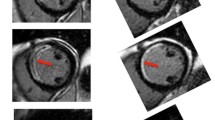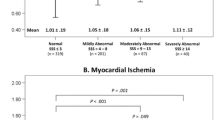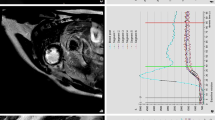Abstract
Background: Assessing the viability in akinetic myocardium is vital for predicting functional recovery after therapeutic management in patients with chronic coronary artery disease (CAD) and depressed left ventricular (LV) function. The present study aimed to evaluate the efficacy of Tc99m MIBI SPECT enhanced with nitroglycerine infusion in detecting myocardial viability, as well as to asses the relationship between the myocardial viability and the subsequent treatment and outcome of patients. Methods and results: Sixty-seven consecutive patients with CAD and LV dysfunction (LV ejection fraction 36.6 ± 8.4%) underwent Tc99m MIBI imaging – at rest and during intravenous nitroglycerine infusion – for viability assessment. Fourteen patients were treated pharmacologically (Group I), and fifty-three (Group II) were submitted to coronary revascularization (PTCR or CABG). Fifteen major cardiac events were observed during 25 months of the follow-up. A significantly worse event-free survival was registered in the subjects of Group I than in Group II subjects. The prognostic predictors of cardiac events were: (1) the number of viable, non-revascularized segments in perfusion imaging (p < 0.001), (2) the severity of the disease assessed by coronary angiography (p < 0.05). Conclusions: Viability detection in nitroglycerine infusion enhanced Tc99m MIBI imaging offers significant prognostic value in patients with CAD after myocardial infarction. Patients with preserved viability showed better prognosis after revascularization than those treated pharmacologically.
Similar content being viewed by others
References
Rahimtoola SH, et al. The hibernating myocardium. Am Heart J 1989;17: 211–221.
Beanlands RSB, Labinaz M, Ruddy TD, et al. Establishing an approach for patients with recent coronary occlusion: identification of viable myocardium. J Nucl Cardiol 1999; 6: 298–305.
Siebelink HJ, Underwood SR, van der Wall EE, Blanksma PK. Detecting hibernating myocardium: how and why. Int J Cardiol 2000; 73: 209–211.
Pagley PR, Beller GA, Watson DD, Gimple LW, Ragosta M. Improved outcome after coronary bypass surgery in patients with ischemic cardiomiopathy and residual myocardial viability. Circulation 1997; 96: 793–800.
Arrighi J, Dilsizian V. Assessment of myocardial viability and its clinical relevance. ACC Current J Rev 2000; 9: S32–S36.
Meluzin J, Cerny J, Frelich M. Prognostic value of the amount of dysfunctional but viable myocardium in revascularized patients with coronary artery disease and left ventricular dysfunction. J Am Coll Cardiol 1998; 32: 912–920.
Lee KS, Marwick T, Cook S, et al. Prognosis of patients with left ventricular dysfunction, with and without viable myocardium after myocardial infarction. Relative efficacy of medical therapy and revascularization. Circulation 1994; 90: 2687–2694.
Bax J, Wijns W, Cornel J, Visser F, Boersma E, Fioretti P. Accuracy of currently available techniques for prediction of functional recovery after revascularization in patients with left ventricular dysfunction due to chronic coronary artery disease: comparison of pooled data. J Am Coll Cardiol 2000; 30: 1451–1460.
Acampa W, Petretta M, Florimonte L, Scotto di Santolo M, Cuoccolo. Sestamibi SPECT in the detection of myocardial viability in patients with chronic ischemic left ventricular dysfunction: comparison between visual and quantitative analysis. J Nucl Cardiol 2000; 7: 406–413.
Marzullo P, Sambuceti G, Parodi O. The role of sestamibi scintigraphy in the radioisotopic assessment of myocardial viability. J Nucl Med 1992; 33: 1925–1930.
Sciagra R, Bisi G, Santoro GM, et al. Comparison of baseline-nitrate technetium 99m sestamibi with rest-redistribution thallium-210 tomography in detecting viable hibernating myocardium and predicting postrevascularization recovery. J Am Coll Cardiol 1997; 30: 384–391.
Li ST, Liu XJ, Lu ZL, et al. Quantitative analysis of technetium 99m 2-methoxyisobutyl-isonitrile single-photon emission computed tomography and isosorbide dinitrate infusion in assessment of myocardial viability before and after revascularisation. J Nucl Cardiol 1996; 3: 457–463.
Maublant JC, Citron B, Lipiecki J. Rest technetium 99msestamibi in hibernating myocardium. Am Heart J 1995; 129: 306–314.
Rocco TP, Disliking V, Strauss HW, Boucher CA. Technetium-99m isonitrile myocardial uptake at rest. II. Relation to clinical markers of potential of potential viability. J Am Coll Cardiol 1989; 14: 1678–1684.
Bisi G, Sciagra R, Santoro GM, Fazzini PF, Rest technetium-99 sestamibi tomography in combination with short term administration of nitrates: feasibility and reliability for prediction of post revascularisation outcome of asynergic territories. J Am Coll Cardiol 1994; 24: 1282–1289.
Sciagra R, Pellegri M, Pupi A, et al. Prognostic implication of Tc-99m sestamibi viability imaging and subsequent therapeutic strategy in patients with chronic coronary artery disease and left ventricular dysfunction. J Am Coll Cardiol 2000; 36: 739–745.
Kang X, Berman DS, Van Train KF. Clinical validation of automatic quantitative defect size in rest technetium 99m sestamibi myocardial perfusion SPECT. J Nucl Med 1997; 38: 1441–1446.
Wackers F. The clinical importance of quantification of stress-rest SPECT radionuclide myocardial perfusion images. ACC Curr J Rev 2000; 9: S20–S25.
Cardiff PM, Phillips HR, Hindeman MC. Prognostic value of a coronary artery jeopardy score. J Am Coll Cardiol 1985; 5: 1055–1063.
Batista J, Pereztol O, Valdes J, et al. Improved detection of myocardial perfusion reversibility by rest-nitroglycerin Tc-99m-MIBI: comparison with Tl-201 reinjection. J Nucl Cardiol 1999; 6: 480–486.
Oudiz R, Smith D, Pollak A, et al. Nitrate-enhanced Thallium 201 single-photon emission computed tomography imaging in hibernating myocardium. Am Heart J 1999; 138: 369–375.
Eitzman D, Al Aouar Z, Kanter HL, et al. Clinical outcome of patients with advanced coronary artery disease after viability studies with positron emission tomography. J Am Coll Cardiol 1992; 20: 559–565.
Gioia G, Powers J, Heo J, Iskandrian AS. Prognostic value of rest-redistribution tomographic thallium-201 imaging in ischemic cardiomiopathy. Am J Cardiol 1995; 75: 759–762.
Cuoccolo A, Pace L, Ricciardelli B, Chiariello M, Trimarco B, Salvatore M. Identification of viable myocardium in patients with chronic coronary artery disease: comparison of thallium-201 scintigraphy with reinjection and technetium-99m-metoxyisobutyl isonitrile. J Nucl Med 1992; 33: 505–511.
Afridi I, Kleiman NS, Raizner AE, Zoghbi WA. Dobutamine echocardiography in myocardial hibernation: optimal 134 dose and accuracy in predicting recovery of ventricular function after coronary angioplasty. Circulation 1995; 91: 663–670.
Schiller NB, Shah PM, Crawford M. Recommendations for quantitation of the left ventricle by two-dimension echocardiography. American Society of Echocardiography Committee on Standards, Subcommittee on Quantitation of Two-Dimensional Echocardiograms. J Am Soc Echocardiogr 1989; 2: 358–367.
Smart SC, Bhatia A, Hellman R, et al. Dobutamine-atropine stress echocardiography and dipyridamole sestamibi scintigraphy for the detection of coronary artery disease: limitations and concordance. J Am Coll Cardiol 2000; 36(4): 1265–1273.
Author information
Authors and Affiliations
Rights and permissions
About this article
Cite this article
Kostkiewicz, M., Olszowska, M., Przewłocki, T. et al. Prognostic value of nitrate enhanced Tc99m MIBI SPECT study in detecting viable myocardium in patients with coronary artery disease. Int J Cardiovasc Imaging 19, 129–135 (2003). https://doi.org/10.1023/A:1022838822502
Issue Date:
DOI: https://doi.org/10.1023/A:1022838822502




